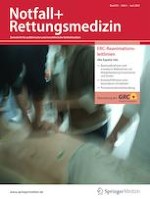Erschienen in:

08.06.2021 | Pflege | ERC Leitlinien
Zur Zeit gratis
Postreanimationsbehandlung
Leitlinien des European Resuscitation Council und der European Society of Intensive Care Medicine 2021
verfasst von:
Jerry P. Nolan, ERC, Claudio Sandroni, ESICM, Bernd W. Böttiger, Alain Cariou, Tobias Cronberg, Hans Friberg, Cornelia Genbrugge, Kirstie Haywood, Gisela Lilja, Véronique R. M. Moulaert, Nikolaos Nikolaou, Theresa Mariero Olasveengen, Markus B. Skrifvars, Fabio Taccone, Jasmeet Soar
Erschienen in:
Notfall + Rettungsmedizin
|
Ausgabe 4/2021
Einloggen, um Zugang zu erhalten
Zusammenfassung
Der Europäische Rat für Wiederbelebung (ERC) und die Europäische Gesellschaft für Intensivmedizin (ESICM) haben gemeinsam diese Leitlinie für die Postreanimationsphase von Erwachsenen erstellt, basierend auf dem internationalen ILCOR Konsensus 2020 zur kardiopulmonalen Wiederbelebung.
Die behandelten Themen umfassen das Postreanimationssyndrom („post-cardiac arrest syndrome“), die Differenzialdiagnose der Ursachen des Kreislaufstillstands, Kontrolle der Oxygenierung und Beatmung, die koronare Reperfusion, die hämodynamische Überwachung und Behandlung, die Kontrolle von Krampfanfällen, die Temperaturkontrolle, das allgemeine Management der Intensivpflege, die Prognose und das Langzeitergebnis, die Rehabilitation und die Organspende.











